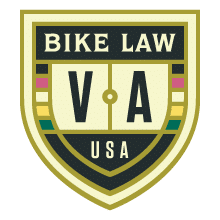It’s important to know your legal rights (and duties) when bicycling in Virginia. It is especially important after a bicycle accident (we call them bicycle “crashes” and explain why here).
This is a general overview of Virginia’s bicycle laws. To see them in their completion, please visit Virginia’s Department of Transportation. Feel free to reach out to Bike Law’s National Director Rachael Maney for further information.
RIGHT to the ROAD
Bicycles are defined as vehicles, and bicyclists generally have all the rights and duties of motor vehicle drivers.
WHERE to RIDE
- Bicyclists are required to ride with the flow of traffic as closely as practicable to the right side of the roadway when traveling at a speed less than traffic.
- Full lane use is allowed when traveling at the normal speed of traffic, preparing for a turn, overtaking and passing, avoiding hazards, traveling in a lane too narrow to share, and avoiding a mandatory turn lane.
- Sidewalk riding is permitted except where prohibited by local ordinances. Bicyclists must yield to pedestrians at crosswalks and on sidewalks and give an audible signal when overtaking bicyclists. Check local ordinances for variations of this rule.
HOW to RIDE
- Bicyclists shall not ride more than two side-by-side, unless on bike paths and may not impede traffic. Bicyclists riding two abreast must move into a single file if they impede the normal flow of traffic. On a laned roadway, bicyclists riding two abreast must ride in a single lane.
- Bicyclists are required to slow down and come to a complete stop at stop signs and traffic devices signaling red.
- Bicyclists must give proper signals that are visible to other bicyclists and cars when turning and stopping.
Bicyclists Overtaking Cars
Bicyclists may overtake and pass another vehicle or bicyclist on either side of the road, staying in the same lane as the overtaken vehicle/bicyclist, or change to a different lane, or ride off the roadway as necessary to pass with safety.
Cars Overtaking Bicyclists
Motor vehicle drivers are required to pass bicyclists at a safe distance of not less than three (3) feet in the same direction.
EQUIPMENT
- Virginia state law does not require bicyclists to wear a helmet. A country, city or town can pass an ordinance to require children 14 years and younger to wear a helmet.
- At night, bicycles must be equipped with a front white headlight visible from 500 feet and a rear reflector visible from 600 feet. When operating on a highway with a speed limit greater than 35 miles per hour (mph), bicyclists must have a rear red tail light visible from a distance of at least 500 feet.
- Every bicycle must be equipped with a brake that will make the braked wheel skid on dry, level, clean pavement.
PROHIBITIONS
- Bicycles may not carry more than the number of persons for which it is designed.
- Clinging to motor vehicles is not permitted.
- Bicycles must be operated with at least one hand on the handlebars.
- Bicyclists may not wear headsets or earphones on both ears while riding.
